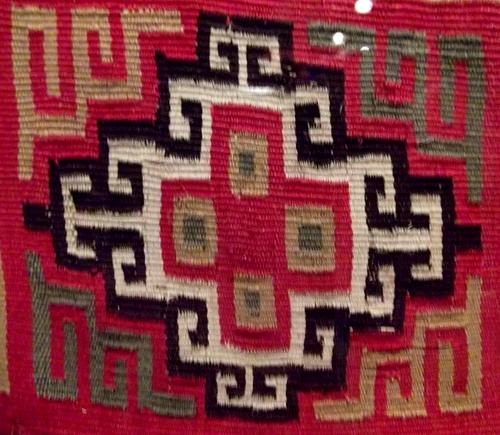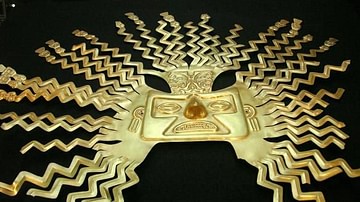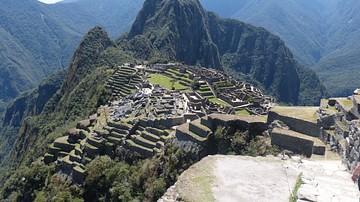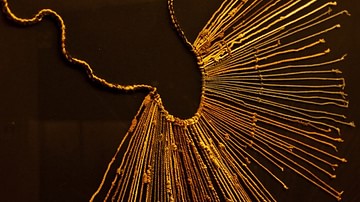For the Incas finely worked and highly decorative textiles came to symbolize both wealth and status, fine cloth could be used as both a tax and currency, and the very best textiles became amongst the most prized of all possessions, even more precious than gold or silver. Inca weavers were technically the most accomplished the Americas had ever seen and, with up to 120 wefts per centimetre, the best fabrics were considered the most precious gifts of all. As a result, when the Spanish arrived in the early 16th century CE, it was textiles and not metal goods which were given in welcome to these visitors from another world.
Although very few examples of Inca textiles survive from the heartland of the empire, and we also know that many textiles were burnt to prevent them from falling into the hands of the Spanish, we do have, thanks to the dryness of the Andean environment, many textile examples from the highlands and mountain burial sites. In addition, Spanish chroniclers often made drawings of textile designs and clothing so that we have a reasonable picture of the varieties in use.
Weavers
It seems that both men and women created textiles, but it was a skill women of all classes were expected to be accomplished at. The principal equipment was the backstrap loom for smaller pieces and either the horizontal single-heddle loom or vertical loom with four poles for larger pieces, such as rugs and blankets. Spinning was done with a drop spindle, typically in ceramic or wood. Inca textiles were made using cotton (especially on the coast and in the eastern lowlands) or llama, alpaca, and vicuña wool (more common in the highlands) which can be exceptionally fine. Goods made using the super-soft vicuña wool were restricted and only the Inca ruler could own vicuña herds. Rougher textiles were also made using maguey fibres.
The finest female weavers (aclla) from across the empire were forcibly relocated to the capital Cuzco to work in the Acllawasi or 'House of the Chosen Women'. Here, too, state sponsored workshops with subsidised workers produced clothing for the nobility and the army. It was here that the finest cloth was made by male specialists known as qumpicamayocs or 'keepers of the fine cloth'. The Incas had three categories of cloth: the roughest was chusi (used primarily for blankets); slightly less coarse and most common was awasca for daily use and the military but which was rarely decorative; and the finest cloth was qompi. The latter was divided into a further two categories - one grade for tribute, the other for royal and religious function. Many burials contained not only textiles but also oblong work-baskets which contained the tools necessary for weaving (spindles, bobbins, spools of thread, and metal pins and needles), indicating that weaving was a highly esteemed craft.
Colours & Meaning
The principal colours used in Inca textiles were black, white, green, yellow, orange, purple, and red. Blue is rarely present in Inca textiles. These colours came from natural dyes which were extracted from plants, minerals, insects, and molluscs. Hundreds of additional colour shades were made from mixing the base palette of pigments. Colours also had specific associations, for example, red was equated with conquest, rulership, and blood. This was most clearly seen in the Mascaypacha, the Inca state insignia, where each thread of its red tassel symbolised a conquered people. Green represented rainforests, the peoples who inhabited them, ancestors, rain and its consequent agricultural growth, coca, and tobacco. Black signified creation and death, while yellow could signal maize or gold. Purple was, as in the rainbow, considered the first colour and associated with Mama Oclla, the founding mother of the Inca race. Finally, foreigners at Cuzco could wear only black garments.
Designs
Besides using dyed strands to weave patterns, other techniques included embroidery, tapestry, mixing different layers of cloth, and painting – either by hand or using wooden stamps. The Incas favoured abstract geometric designs, especially checkerboard motifs, which repeated patterns (tocapus) across the surface of the cloth. Certain patterns may also have been ideograms and so carried a specific meaning, but the issue continues to be debated by scholars. Non-geometrical subjects, often rendered in abstract form, included felines (especially jaguars and pumas), llamas, snakes, birds, sea creatures, and plants. Clothes were simply patterned, commonly with square designs at the waist and fringes and a triangle marking the neck. One such design was the standard military tunic which consisted of a black and white checkerboard design with an inverted red triangle at the neck.
Designs could be specific to family groups (ayllu), and one of the reasons for repeated designs was that textiles were often produced for the state as a tax and so textiles could be representative of specific communities and their cultural heritage. Just as today's coins and stamps reflect a nation's history, so too Andean textiles offered recognisable motifs which either represented the specific communities making them or the imposed designs of the ruling Inca class ordering them. At the same time, just as the Inca imposed a political dominance over their conquered subjects, with art they imposed standard Inca forms and designs, but they did allow local traditions to maintain their preferred colours and motifs. It is also notable that, as with pottery decoration, Inca textiles did not include representations of themselves, their rituals, or such common Andean images as monsters and half-human, half-animal figures which are seen in other art forms.
Additional decoration could be added to articles in the form of tassles, brocade, feathers, and beads of precious metal or shell. Precious metal threads could also be woven into the cloth itself. As feathers were usually from rare tropical birds and condors, these garments were reserved for the royal family and nobility.
Functions
Inca clothes were simple in style, and most were made using either cotton or wool. The typical male attire was a loincloth and a simple tunic (unqo) made from a single sheet folded over and stitched at the sides with holes left for the arms and neck. In winter a cloak or poncho was worn on top. Women typically wore a single large cloth wrapped around the body which was pinned at the shoulder and held in place with a waist belt or sash known as a chumpi. On top of this a cloak could be worn, again pinned at the front. Both sexes wore cloth hats or headbands. This headgear could indicate clan groups or social status both in their design and with the addition of feathers and precious metal decorations.
Clothing was a great status symbol in Inca society and an easily recognisable indicator of a person's wealth and status. Rulers and nobility were also buried wrapped in multiple layers of fine textiles. Such was the value given to fine textiles that the Incas often required its production as tribute or tax (mit'a - working for the state) from conquered peoples. To this end specific quantities of wool or cotton were given to subject weavers each year so that they might produce a calculated quantity of textiles. Those textiles which involved the most labour to produce were considered the most valuable. Indeed, textiles were so valued that they became in effect a currency; for example, the state paid units of soldiers and those who had rendered a service with cloth.
Other goods made from textiles included bags, for the storage of, for example, coca leaves. These were frequently decorated with the addition of tassles. Sleeping mats, blankets, sacks, saddle bags, the uppers of shoes, and wall hangings were also made from textiles. Small votive figure dolls were also dressed in textiles and left in burial chambers. And textiles were given as gifts in important society rituals such as weddings, births, and rites of passage, and could be burned as votive offerings to the gods. Finally, mention should be made of the Inca quipu, the complex string recording device where knots and colours were used to record specific goods and messages.








